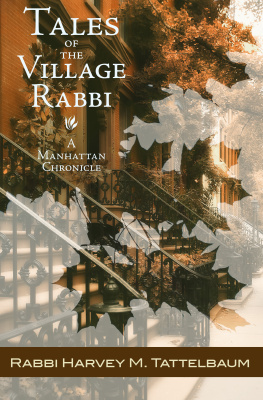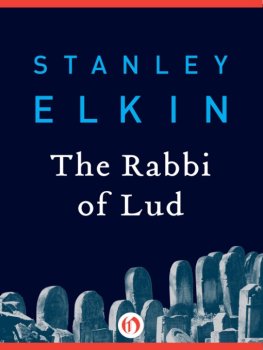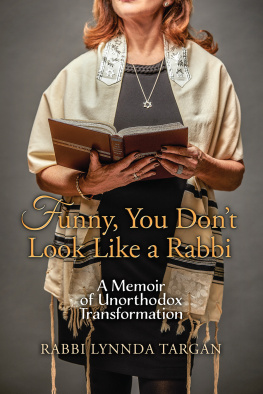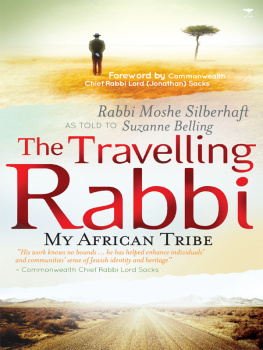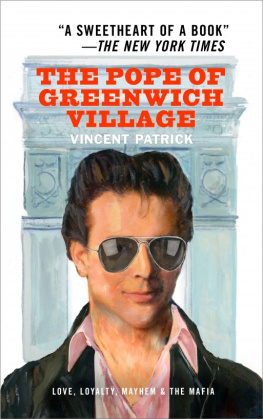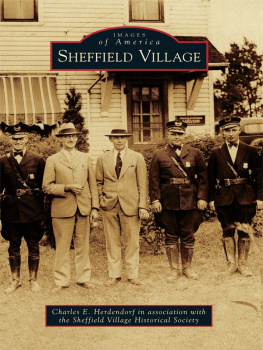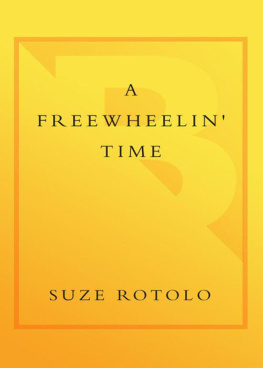Tales of the Village Rabbi
A Manhattan Chronicle
Rabbi Harvey M. Tattelbaum

Dedicated with profound love to
My darling Meryl;
Adam Tattelbaum; Kate Gun; and Polly Schnell;
Their loved ones:
Nancy Rosenfeld; Howard Gun; and Gordon Schnell
And
Jack and Tess Tamar
Jesse and Emory Gun
And
Wynter, Rayn, and Quoya Schnell
*
And
Warm thanks from the author to
Leslie Curtis, Editor
Richard Curtis, Agent
And
Michael Gaudet of E-Reads, Publisher
Disclaimer: The names and identities of many of the characters in these stories have been changed. The stories are true.
Introduction
It was not a town in the Ukraine or Belarus, nor a shtetl in Poland or Lithuania, nor a shtiebele in Russia or Azerbaijan.
It has been a bustling, thriving village on the Island of Manhattan for over three hundred years. Its settlers and occupants were from all the nations of the earth.
As the population of the whole island grew, a line of demarcation became pronounced. It had no Yiddish, Hungarian, Russian or Polish tones to itsimply 14th Streetthe northern boundary. The southern boundary was vague and darted in and out of lower Manhattan, a boundary that touched Chinatown, Little Italy, the Lower East Side, the wholesale meat districtall venues of crowded, busy and unrelenting vitality.
Many who settled here felt a certain pride of residencea pride that often kept them below 14th Street, if possible. A pride that allowed them to respond without any self-effacement to the question, Where do you live? and the quickly forthcoming answer was Greenwich Village.
Land values in The Village have skyrocketed. Apartments are being rented or bought for prices that surpass the levels of many comparable Upper West Side and Upper East Side dwellings in Manhattan.
My years as part of The Village community were among the most exciting of my life. Many descendants of the ancient house of Israel settled there. Among the families I knew, some claimed residency back two or three or more generations (one, even back to the time of the Pilgrims of the 17th century).
The pride of being part of the inner and immediate life of The Village was an integral part of the worldview of many of my Jews. One found an easy acceptance among denizens of all that made The Village famous throughout the world: the art shows; the gay rights parades; the outrageous adult Halloween processions; the dousing in the fountain of NYU graduates at commencement-time; the community battles to keep NYU from expanding its libraries and learning centers; the illogical pattern of crisscrossing charm-filled streets; the crowded stores and eating places; the constant hordes of tourists and passers-through; the beggars and homeless; the high-cost brownstones and the imposing new apartment buildings; St. Vincents Hospital; the Fashion Institute; the New School and the private schools; the centuries-old fabulously wealthy churches; the old clubsand for me, above all, the gathering places of the Jewish community. One, in particular, on 12th Street between University Place and Broadway: Congregation Bnai Israel of Greenwich Village. Though not the only synagogue in the area, under its better-known title as The Village Temple, it enabled me to claim the title of Village Rabbi. That was where I explored, served and led for an era of my life that I cannot ever put out of my mind.
That was where I workedand these are some of my stories.
A Bracha For A Bike
I recall that the day was sunny, cool, and beautiful. I had sat down at my desk to return phone calls and write some letters and my rabbis article for our temple publication. I was well into my agenda when the intercom buzzed. The temple secretary informed me that a person was here to see me on an important matter.
In my entire career I never turned anyone away who did not have an appointment.
A gentle knock on the door followedand in walked the most handsome, the most beautiful man I had ever seen. He was dressed in leather from head to toeexcept that his leather cap was in his hand. It was not old creased leatherit was shiny and a bit stiff. I could hear leathery brittleness as he moved closer to my desk. He had a luminous smile that lit up my study and a smile that simply radiated a pearliness rarely seen. He also seemed extraordinarily friendly and sweetly nave.
I shook his hand and introduced myself. In his haste to get to his important matter, he overlooked giving me his name.
He got right to the point: Rabbi, would you please bless my new motorcycle?
I was a bit stunned. I had never blessed any kind of machine before. I didnt really want to. I couldnt help but react cynically in days gone by to the big churches in town that blessed pets and other animal companionsor Bishops who blessed the recreation and fishing boats at the docks of the Hudson and elsewhere.
But there was something so guileless, so ingenuous about him and the way he asked for the blessing. It was not in me to say no.
I answered that I would bless him-a living human being-but not his motorcycle, an inanimate object. I would wish for the best for him: for sunny days and happy journeys, for strength, good judgment, good fortune, and good health. But I could not bless his motorcycle.
Please, he asked, come downstairs and see it. I was happy to go with him. In spite of the fact that his gleaming, shiny bike, with every possible chrome feature added to it, was in my parking spot in front of the Temple entrance (I often came to work by subway), I had to admit it, his motorcycle was an object of beauty. One could feel the love, the handwork, the care, the elbow grease, the polish lavished upon it.
You see, he said, it lives!
Something deep in my own animist soul agreed, but my rationalist Weltanschauung won out. I put my hand upon his shoulder. I blessed him as kindly and as lovingly as I could. I even put my other hand on his gleaming, inanimate, significant other-and ended with a moment of silent prayer before the final amain. When I had finished and informally wished him all kinds of good luck and happy riding, he climbed on the vehicle with a look of pride and satisfaction. He started upa deep roaring, reverberating sound (probably illegal for the city)and gunned it in neutral a few times. Above the din, he shouted, Thanks Rabbi! and roared off on 12th Street into the sunset.
I couldnt help but smile. I never saw him again. When I see gleaming bikes along the highways, I am reminded of the wonder of 12th street! It was a fitting jump-start for the Rabbi in the Village.
Of Broken Glass
When I first came to New York City with my wife, I served as an Assistant Rabbi at a large east side uptown congregation. The position had a mandatory termination after the third year.
I went through all the proper protocol of placement and was engaged to serve the Village Temple on East 12th Street. I always felt that it would be beneficial professionally to live near the temple.
With the oncoming birth of our first son followed by our first daughter, we did not plan to move. The commute was easy and quick. Our apartment on East 86th Street was not far from the Lexington Avenue subway line, and both East 86th Street and East 14th Street were express stops.
Although the subway ride was convenient, we still eventually planned to move downtown. We looked at many places. Spiritually we had already moved but physically we conducted a constant search. We found one apartment on lower Fifth Avenue that was truly lovely and held great possibilities for our growing family. That apartment was large, with rooms of outstanding size in an old apartment building designed by the famous architect Stanford White.

